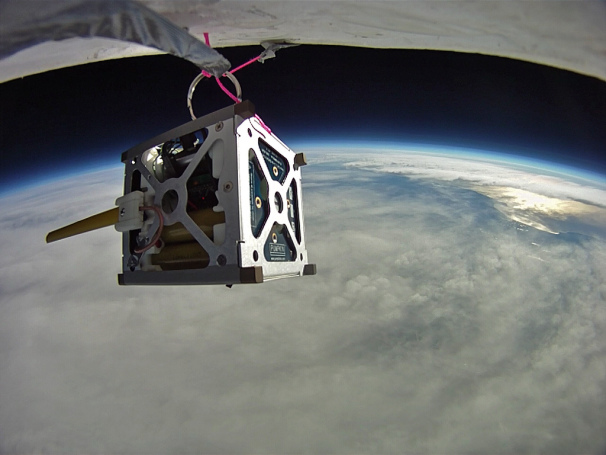NASA Launching Mini Satellites Powered by Nexus One Phones
NASA is taking the cheap but effective route by launching 4-inch satellites using Android phones as the on-board computer. Brilliant.
E.T. won't need to fall to the Earth to phone home: he'll be able to grab one of NASA's cube-like miniature satellites -- roughly the size of a coffee mug -- later this year. They'll reportedly be powered by Google's Nexus One smartphones and include external batteries, an external radio beacon, and a watchdog circuit that will monitor the system and reboot the Android smartphone if necessary.
On Friday NASA said its cube-shaped, pre-Borg-like satellites are part of the PhoneSat Project aimed to make extensive use of commercial-off-the-shelf components, including an unmodified, consumer-grade smartphone. A small team of engineers is working on the project at the agency's Ames Research Center at Moffett Field, Calif., and are taking the same "release early, release often" smartphone route with the small spacecraft.
"Out of the box, smartphones already offer a wealth of capabilities needed for satellite systems, including fast processors, versatile operating systems, multiple miniature sensors, high-resolution cameras, GPS receivers, and several radios," NASA said.
By using only commercial-off-the-shelf hardware and keeping the design and mission objectives to a minimum for the first flight, the team was able to build each of the three prototype satellites in the PhoneSat project for $3,500. Each NASA PhoneSat nanosatellite is one standard CubeSat unit in size (approx. 4-inches) and weighs less than four pounds.
"NASA PhoneSat engineers also are changing the way missions are designed by rapidly prototyping and incorporating existing commercial technologies and hardware," NASA said. "This approach allows engineers to see what capabilities commercial technologies can provide, rather than trying to custom-design technology solutions to meet set requirements. Engineers can rapidly upgrade the entire satellite's capabilities and add new features for each future generation of PhoneSats."
According to the report, the Nexus One smartphone acts as the spacecraft's on-board computer. Sensors are used for orientation while the camera will be used for Earth observations. This 1st-generation satellite -- PhoneSat 1.0 -- will have a simple mission: to stay alive in the frigid vacuum of space long enough to send back images of earth and space while sending data about its overall health in the process.
Once that mission is completed, NASA will move on to the next-generation PhoneSat (2.0) featuring the zippier Nexus S smartphone. This device will add a two-way S-band radio to the core PhoneSat design to allow engineers to command the satellite from Earth. Solar panels will also be added to enable longer missions as well as a GPS receiver. The team will also throw in magnetorquer coils – electro-magnets that interact with Earth's magnetic field – and reaction wheels to actively control the satellite's orientation in space.
Get Tom's Hardware's best news and in-depth reviews, straight to your inbox.
Three NASA PhoneSats systems (two PhoneSat 1.0's and one PhoneSat 2.0) are scheduled to launch aboard the maiden flight of Orbital Sciences Corporation's Antares rocket from NASA's Wallops Flight Facility at Wallops Island, Va., later this year, NASA said. The image provided above is a PhoneSat 1.0 satellite during a high-altitude balloon test.
Later in 2013, NASA's upcoming Edison Demonstration of Small Satellite Networks mission -- part of the Small Spacecraft Technology Program -- will demonstrate the possibility of conducting heliophysics measurements using small spacecraft.
For more information about the smartphone satellites and additional photos, head here.

Kevin Parrish has over a decade of experience as a writer, editor, and product tester. His work focused on computer hardware, networking equipment, smartphones, tablets, gaming consoles, and other internet-connected devices. His work has appeared in Tom's Hardware, Tom's Guide, Maximum PC, Digital Trends, Android Authority, How-To Geek, Lifewire, and others.
-
sourgrapes01 They were going to use iPhones, since they are much faster and better than Android phones at everything, but Android phones are much cheaper and the government is cutting costs.Reply
-
Vorador2 I wonder how it will fare against radiation since the phone is not shielded. Guess that's part of test.Reply -
fb39ca4 sourgrapes01They were going to use iPhones, since they are much faster and better than Android phones at everything, but Android phones are much cheaper and the government is cutting costs.Making satellites is not an Apple-approved use of an iDevice.Reply -
azraa Vorador2I wonder how it will fare against radiation since the phone is not shielded. Guess that's part of test.You can get Pb/Ceramic coating from the shelves at a specialized hardware store. Sum 1+1 and there you goReply -
guru_urug sourgrapes01They were going to use iPhones, since they are much faster and better than Android phones at everything, but Android phones are much cheaper and the government is cutting costs.Reply
They didnt use iPhones cause Apple is financially worth more than NASA and NASA feared a lawsuit for their rectangular shaped satelites.
In any case its good they didnt use iPhones, its difficult to orient in space and if the satellite held the phone wrong, NASA engineers would lose communication with the satellite -
Azimuth01 This was done about 3 years ago by a guy and his son in their backyard. The phone was taken up to a high altitude using a weather balloon, then a hobby rocket was ignited from a platform on the balloon and launched the phone into lower space. It took videos and pictures, then fell back to earth with a small parachute and was recovered using the phones internal GPS.Reply
This is what NASA has been reduced to? -
HDmac Replywatchdog circuit that will monitor the system and reboot the Android smartphone if necessary
Sums up my android experience pretty well. -
noob2222 They didn't use the iPhone because they couldn't get the software past apples app store approval.Reply
